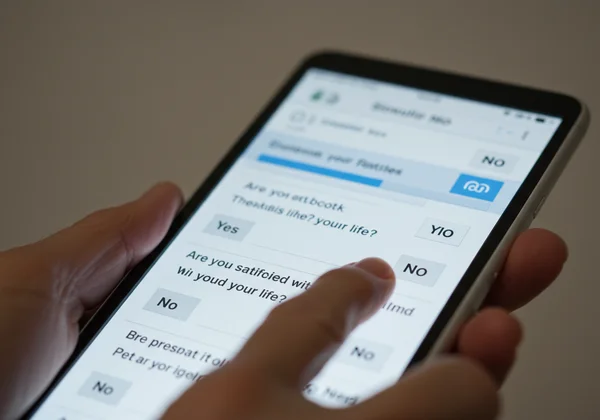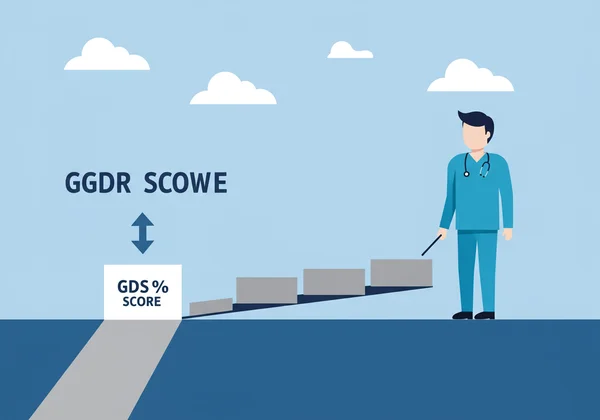Is GDS a Diagnostic Tool? Understanding Its Limitations
The Geriatric Depression Scale (GDS) stands as a widely recognized and powerful tool for understanding the emotional well-being of older adults. It provides invaluable insights into feelings that might otherwise remain hidden. As more individuals—from seniors themselves to caregivers and clinicians—access online versions, a fundamental question emerges: Is the Geriatric Depression Scale a diagnostic tool? Clarifying its precise role is essential for its responsible and effective use.
This article delves into the true purpose of the GDS, exploring its function as a vital screening instrument. We'll examine the crucial distinctions between a screening result and a clinical diagnosis, and guide you through the important next steps after receiving a score, empowering you to use the GDS as a helpful starting point for meaningful conversations, rather than a final judgment. You can take the free GDS test on our site to begin this important conversation.
What is Geriatric Depression Screening?
Before we can understand the GDS's limitations, we must first grasp the concept of screening in a healthcare context. Geriatric depression screening is not about finding a definitive answer but about identifying potential risks. It acts as an early warning system, flagging individuals who might benefit from a more thorough evaluation by a professional. Such proactive screening is vital for early intervention and improved health outcomes.
Screening helps to cast a wide net, catching signs of concern that might otherwise be missed in a routine check-up. For older adults, symptoms of depression can sometimes be mistaken for normal signs of aging or other medical conditions. A dedicated screening process helps to focus attention specifically on emotional health, providing a clear and structured way to open a discussion.

The Role of Screening Tools in Mental Health
In mental health, screening tools are like smoke detectors. A smoke detector can't tell you if there's a small kitchen fire or a major house blaze, but it alerts you to the presence of smoke, signaling that you need to investigate further. Similarly, a mental health screening tool like the GDS doesn't provide a diagnosis. Instead, it indicates the presence and severity of depressive symptoms, suggesting that a closer look is warranted.
These user-friendly tools offer quick and accessible assessment. They use a standardized set of questions to gather information objectively. This process helps to initiate a conversation about mental health that can sometimes be difficult to start, providing a solid foundation for a more in-depth discussion with a healthcare provider. Our free GDS screening is designed for this very purpose.
How the GDS Works as a Preliminary Assessment
The Geriatric Depression Scale works by asking a series of simple "yes/no" questions about how an individual has felt over the past week. For example, it might ask, "Are you basically satisfied with your life?" or "Do you often feel helpless?". Each answer contributes to a total score. This score then corresponds to a range indicating the likelihood of depression—from normal to mild or severe.
It is a preliminary assessment, a first step. The result is a number, a data point that provides a snapshot in time. It doesn't explore the "why" behind the feelings or consider other contributing factors like physical illness, medication side effects, or recent life events. Think of it as taking your temperature when you feel unwell; a fever suggests something is wrong, but it doesn't tell you if you have the flu, a cold, or an infection.

GDS vs. Diagnosis: Understanding the Key Differences
The most critical takeaway is the distinction between a GDS score and a formal diagnosis. Confusing the two can lead to unnecessary anxiety or, conversely, a false sense of security. A screening tool provides a clue, while a diagnosis provides a comprehensive clinical explanation. Recognizing this difference is key to using the GDS responsibly and productively.
A score from the Geriatric Depression Scale online is an indicator, not a label. It is a piece of information to be shared and interpreted within a broader clinical context. The ultimate goal of the GDS is to bridge the gap between initial concern and professional evaluation, ensuring that no one falls through the cracks.
Why the GDS Isn't a Standalone Diagnostic Tool
The GDS is intentionally limited in scope, which is what makes it such an efficient screening tool. However, these same characteristics prevent it from being a standalone diagnostic tool. Here are the primary reasons:
- Lack of Context: The GDS doesn't account for an individual's life situation, medical history, or other stressors. A high score could be related to grief, a recent illness, or side effects from a new medication—factors that require a clinician's insight to untangle.
- Exclusion of Physical Symptoms: The scale was specifically designed to focus on the psychological aspects of depression in older adults, intentionally minimizing questions about physical symptoms that could overlap with other age-related health issues. A full diagnostic evaluation, however, must consider both physical and emotional symptoms.
- No Professional Interpretation: A score is just a number. A diagnosis involves a trained professional's judgment, experience, and ability to observe non-verbal cues, understand nuanced answers, and ask follow-up questions.
- Risk of Misinterpretation: Without clinical guidance, a person might overreact to a high score or dismiss a concerning one. A professional can help interpret the GDS score interpretation correctly and place it in the proper perspective.
The Comprehensive Process of a Clinical Diagnosis
Receiving a clinical diagnosis of depression is a much more thorough and personalized process than completing a questionnaire. It is conducted by a qualified healthcare professional, such as a doctor, psychiatrist, or psychologist. This comprehensive evaluation typically includes several components:
- Detailed Interview: A deep conversation about your symptoms, feelings, personal history, family history, and daily life.
- Physical Examination: To rule out any underlying medical conditions that could be causing depressive symptoms, such as thyroid problems or vitamin deficiencies.
- Review of Medications: An analysis of current prescriptions to see if side effects could be a contributing factor.
- Psychological Evaluation: The clinician will assess your thoughts, feelings, and behavior patterns to see if they align with the established criteria for a depressive disorder as outlined in diagnostic manuals like the DSM-5.
This multifaceted approach ensures that the final diagnosis is accurate, comprehensive, and leads to an appropriate and effective treatment plan.

The Importance of Professional Medical Consultation
If a GDS score suggests the possibility of depression, the single most important action is to seek professional medical consultation. A score is not something to fear, but rather a powerful piece of information to act upon. It is a sign that it's time to have a conversation with someone who can help. Sharing your results with a doctor is a proactive and courageous step toward protecting your mental health.
Never attempt to self-diagnose based on a GDS score alone. The expertise of a healthcare provider is irreplaceable. They can provide the clarity, guidance, and support needed to navigate the path forward, whether that involves further monitoring, therapy, medication, or lifestyle adjustments. You can start the assessment now to get a baseline to discuss with your provider.
When Your GDS Score Indicates a Need for Further Assessment
A score on the Geriatric Depression Scale (GDS-30) of 11 or higher, or a score on the short form (GDS-15) of 6 or higher, is generally considered an indication that further assessment is needed. This doesn't automatically mean you have clinical depression, but it strongly suggests that your symptoms are significant enough to warrant a professional opinion.
Think of this score as your cue to schedule an appointment with your family doctor or a mental health specialist. You have taken a valuable first step in monitoring your emotional health; the next step is to bring that information to an expert who can help you understand what it means and what to do about it.
Preparing for a Discussion with Your Healthcare Provider
To make your appointment as productive as possible, a little preparation goes a long way. This will help your doctor get a clear picture of what you've been experiencing. Consider the following steps:
- Bring Your GDS Score: Print out or write down your score and the date you took the test. Mentioning you used a tool like the gds geriatric depression scale gives them a useful starting point.
- List Your Symptoms: Note any changes you've noticed in your mood, sleep, appetite, energy levels, and interest in activities.
- Note Key Life Events: Have there been any recent changes, losses, or stressors? Mention these to your doctor.
- Prepare Questions: Write down any questions you have. For example, "Could my other health conditions be affecting my mood?" or "What are the next steps for evaluation?"
Being prepared helps you advocate for your own health and ensures you and your provider can work together as a team.
GDS: A Vital Screening Tool, Not a Diagnosis
The Geriatric Depression Scale is an invaluable ally in the effort to promote mental wellness in older adults. It is a scientifically validated, simple, and effective way to open the door to conversations about emotional health. However, its power lies in its proper use as a screening tool—a way to identify risk, not to provide a definitive diagnosis.
Remember, a score from the GDS is a starting point, not an endpoint. It is a signal to explore further, a reason to connect with a healthcare professional, and a step toward understanding and managing your emotional well-being. By embracing the GDS for what it is, we can use it to foster early detection and support those we care about on their journey to better mental health.
Ready to take the first step? Use our free, confidential, and easy-to-use online GDS tool today. Share your results with a trusted professional and begin the conversation.

Frequently Asked Questions About the Geriatric Depression Scale
Is the Geriatric Depression Scale a diagnostic tool?
No, it is not. The GDS is a screening tool designed to detect potential signs of depression in older adults. A high score indicates that a full diagnostic evaluation by a qualified healthcare professional is recommended. It is a first step, not a final answer.
What does a high score on the Geriatric Depression Scale mean?
A high score suggests that you are experiencing a significant number of depressive symptoms. It serves as a strong indicator that you should consult with a doctor or mental health professional for a comprehensive assessment to determine the underlying cause and discuss potential next steps.
Who can use the Geriatric Depression Scale?
The GDS is designed for older adults but can be used by anyone involved in their care. This includes seniors themselves for self-assessment, family caregivers monitoring a loved one's well-being, and healthcare professionals like doctors and nurses for quick clinical screening.
What is a normal score on the Geriatric Depression Scale?
On the full 30-item GDS, a score of 0-9 is typically considered in the normal range. On the 15-item short form, a score of 0-5 is considered normal. However, even with a normal score, you should always speak with a professional if you have concerns about your mental health. You can easily discover your results on our platform.